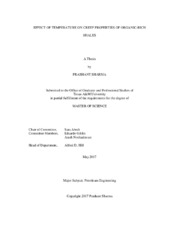| dc.description.abstract | Understanding the creep properties of gas shales at elevated temperatures is critical for accurately predicting reservoir performance and assessing the effect of viscous behavior on closure rate, production rate, and conductivity loss. In order to better understand creep properties at in-situ conditions, a quantitative relationship between temperature, mechanical properties, and complex chemo-physical mechanisms that causes thermal alteration needs to be obtained. In this study, elastic, strength, and creep properties of organic-rich shales are investigated by a combination of nanoindentation, energy dispersive x-ray spectroscopy, and micromechanical modeling over a range of temperatures (23-350ᵒC). In particular, elastic and strength properties are extracted through nanoindentation between temperatures of 23-350ᵒC and creep properties are measured similarly between temperatures of 23-300ᵒC. Within the allotted temperature range, the elastic and strength properties of the porous clay/kerogen phase remains unchanged due to the highly mature organic matter and low water content present within the matrix. A similar behavior is noticed in the creep modulus from temperatures 23-200ᵒC where it remains relatively unchanged and shows an isotropic characteristic. However, the creep modulus of the clay phase increases at 300ᵒC in both parallel and perpendicular directions to the bedding plane. In addition, the indentation modulus and hardness increase at 300ᵒC are a result of the enhancement of particle sliding and compaction of clay particles due to the transformation of organic matter to hydrocarbons. Analysis of the creep data obtained in this experimental effort sheds light on the dictating role of organic matter and porosity on creep properties of organic-rich shales and emphasizes the pivotal role of organic matter in the time-dependent response. Specifically, the isotropic increase also suggests that the isotropic phases, which are organic matter and porosity, play an important role in driving creep properties in shales. Evaluation of the probability density functions (PDF) of the contact creep modulus suggests that a bimodal distribution occurs between temperatures of 23-200ᵒC which corresponds to two different modes: the clay/kerogen mode (mode I) and the porous clay mode (mode II). However, at 300ᵒC, a unimodal trend exists that aligns closely with mode II, indicating that it is only linked to the porous clay phase rather than the clay/kerogen mode. | en |


